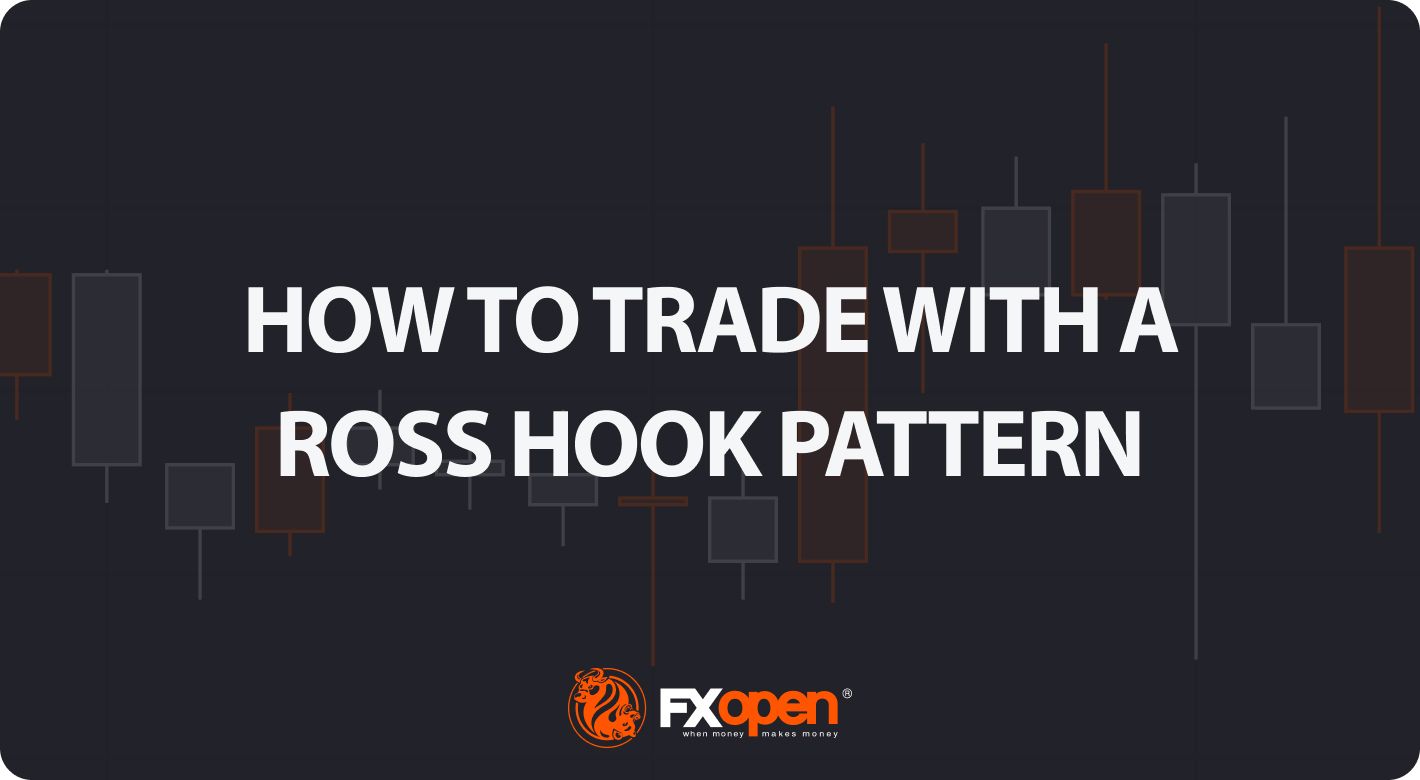FXOpen

In the realm of technical analysis, certain patterns stand out for their efficacy and the insights they offer traders. Among them is the Ross Hook pattern, deeply rooted in the foundational 1-2-3 pattern. This article delves into understanding these patterns, their origin, and how traders can integrate them into their strategies. Dive in to unravel the nuances of trading using the Ross Hook and the 1-2-3 pattern.
Background of Ross Hook
The Ross Hook pattern, often revered for its distinctiveness, is an offspring of the classic 1-2-3 pattern seen in technical charting. Its moniker, the "Ross Hook", is attributed to its characteristic hook-like appearance that forms subsequent to a breakout of the 1-2-3 pattern.
Originating from trader Joe Ross's work, it garnered respect and attention in trading circles due to its potential to offer added layers of market insight. This pattern aids traders in identifying continuation points after a trend is already underway, making it a favourite for those eyeing sustained momentum or retracements in the market. Over the years, as its efficacy has been put to the test, the Ross Hook has emerged as a reliable companion for traders, seamlessly dovetailing with the foundational principles of the 1-2-3 pattern.
Below, we break down both patterns and how they fit into each other. For the best understanding, try following along on live charts using FXOpen’s free TickTrader platform.
Understanding the 1-2-3 Pattern
The 1-2-3 pattern is a foundational technical formation often observed in price charts, offering traders insights into potential trend reversals. To clearly identify this structure, traders typically look for three distinct pivot points in price movements:
- The first pivot, or "1", is a turn in the price during an existing trend. It signals the potential beginning of a change.
- The second pivot, or "2", often forms outside the existing trendline, suggesting the trend could be losing steam.
- The third pivot, or "3", is crucial; for a valid 1-2-3 structure, this point should not exceed the height of the first pivot. Essentially, it solidifies the potential reversal.
Upon successfully identifying the 1-2-3, it becomes a precursor to the Hook pattern trading strategy, where traders use the initial formation as an entry setup to potential trading opportunities.
Entry
- Traders typically enter on the break above (bullish reversal) or below (bearish reversal) the second pivot point.
Stop Loss
- Considerations usually lean towards setting the stop loss beyond the third pivot, safeguarding against sudden market volatility.
Take Profit
- Often, traders measure between the first and second pivot points, using this distance to gauge potential profit targets.
Introducing the Ross Hook Pattern
Emerging as an extension of the 1-2-3 pattern, the Ross Hook is a notable formation in technical trading. This pattern appears after the breakout of the 1-2-3 and is distinguished by a slight deviation or "hook" in the price movement, often resembling a minor 1-2-3 pattern itself.
To break it down:
- Following the breakout from a 1-2-3 pattern, traders observe a retracement in price.
- This retracement, instead of developing into a full-fledged reversal, stalls and forms a smaller 1-2-3 structure.
- The Ross Hook can be an indicator of trend continuation after a larger 1-2-3 pattern.
Entry
- For those trading the Ross Hook, the breakout of the initial 1-2-3 pattern serves as the first cue.
- A retest or minor retracement forms a smaller 1-2-3, with a breakout of this pattern signalling an entry. Many traders will look for a brief retracement to enter.
Stop Loss
- Traders commonly place stop losses just beyond the lowest point of the hook, aiming to curtail potential losses.
Take Profit
- A popular method entails measuring the distance from the start of the 1-2-3 point to the Ross Hook's peak, utilising this range to assess profit potential.
Considerations When Using the Ross Hook Trading Strategy
Navigating the complexities of the Ross Hook demands more than mere pattern recognition. It's essential to be equipped with tailored strategies that cater to the unique nature of the Ross Hook. Here are specific considerations you may take into account when incorporating this approach into your trading strategy:
- Contextual Analysis: The Ross Hook should be interpreted within the broader market context. For instance, during strong market trends, the pattern might indicate a brief consolidation before continuation.
- Volume Verification: Strong volume during the breakout of the 1-2-3 structure, followed by decreasing volume during the formation of the Ross Hook, can serve as additional validation.
- Support and Resistance: Cross-referencing the Ross Hook's formation with existing support and resistance levels can provide better entry and exit points.
- Timeframe Sensitivity: While the Ross Hook can form on various timeframes, its reliability often increases on longer timeframes, reducing the noise of shorter ones.
- Combining with Indicators: Using oscillators, like the Stochastic RSI, alongside the Ross Hook can help confirm potential overbought or oversold conditions, enhancing decision-making accuracy.
The Bottom Line
In summary, the Ross Hook and the foundational 1-2-3 pattern offer traders valuable tools to navigate the often turbulent waters of the financial markets. Their practical applicability makes them indispensable for those seeking to bolster their trading strategies.
For those eager to put these insights into practice and benefit from a robust trading environment, consider taking the next step to open an FXOpen account. As with any trading approach, the right platform can make all the difference in leveraging these time-tested patterns.
This article represents the opinion of the Companies operating under the FXOpen brand only. It is not to be construed as an offer, solicitation, or recommendation with respect to products and services provided by the Companies operating under the FXOpen brand, nor is it to be considered financial advice.
Stay ahead of the market!
Subscribe now to our mailing list and receive the latest market news and insights delivered directly to your inbox.








